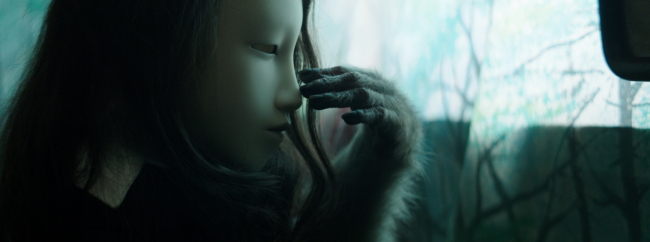The Seoul International Media Art Biennale will be bigger and more diverse this year as the largest media art exhibition in the country will take place at all four branches of the city-run Seoul Museum of Art, featuring a wide mix of artists including those from Latin American and African countries.
“It will be a challenge for the museum (to dedicate all museum space to the biennale), but we expect this will make Seoul a hub for contemporary art during the biennale period,” said Kim Hong-hee, director of the Seoul Museum of Art, at a news conference in Seoul yesterday.
 |
| “(Untitled) Human Mask” by Pierre Huyghe (Courtesy of the artist/Seoul Museum of Art) |
 |
| “(Untitled) Human Mask” by Pierre Huyghe (Courtesy of the artist/Seoul Museum of Art) |
“We will feature more young artists, female artists and artists from Latin American and African countries so that we can offer a balanced view of contemporary art to our audience,” said Beck Jee-sook, the former director of Arko Art Center and artistic director of the Anyang Public Art Project who was appointed to curate the exhibition last May.
In fact, women make up half of the 50 or so artists who have been invited to showcase their works at the biennale, which has been dubbed Media City Seoul. The number of young artists is 30 percent higher than before, according to Beck.
 |
| Beck Jee-sook, artistic director of the 9th Seoul International Media Art Biennale (Seoul Museum of Art) |
The biennale takes its theme “Neriri Kiruru Harara” from a poem by well-known Japanese poet Shuntaro Tanikawa about an alien on Mars and its imaginary relationship with human beings. The phrase, which appears in the poem in an imaginary language spoken by the alien, represents the biennale’s attempt to explore an unknown future, Beck explained.
“In line with the theme, we will gather media artworks that predict or anticipate the future in their own unique ways,” said Beck. “I expect young artists will offer interesting views on the future through the innovative use of media and technology.”
Take for example, Korean artist Cha Jae-min, 30, who will recreate the meetings of the minimum wage committee, which have been held since 1987 in Korea. She will base this on news reports and accounts from committee members and participants, with the aim of predicting the minimum wage level of the future.
 |
| “Hysteric” by Cha Jae-min (Courtesy of the artist/Seoul Museum of Art) |
 |
| “Hysteric” by Cha Jae-min (Courtesy of the artist/Seoul Museum of Art) |
“The meetings have never been revealed to the public. All we know is the result of the meetings, which show the fixed minimum wage for the year. By gathering past data, information and accounts from the people related to the meetings, I would like to predict the future level of minimum wage and our life related to it,” said Cha, at the press conference.
To publicize the biennale, Seoul Museum of Art will publish and distribute free magazines about contemporary media art throughout Seoul from March to August.
In August, it will hold summer camps that invite art educators, students and those with disabilities to explore the art-making process at the southern Nam Seoul Living Arts Museum and northern Buk Seoul Museum of Art.
Media City Seoul 2016 will run from Sept. 1 to Nov. 20.
By Lee Woo-young (wylee@heraldcorp.com)



